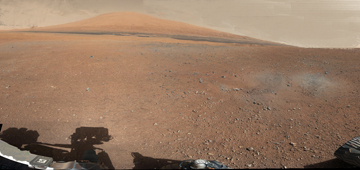
by SpaceJace | Oct 12, 2012 | News
A rock on Mars, discovered by NASA’s Curiosity rover, is surprisingly similar to a well-known kind of rock on Earth.
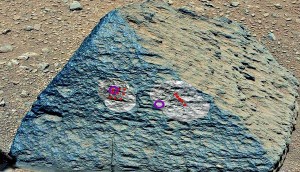
Earth-like Rock discovered on Mars (credit: NASA/JPL)
This type of rock is the first of its kind encountered on Mars. The 16-inch-tall pyramid-shape rock is named “Jake Matijevic” in honor of a Curiosity mission team member who died in August. Curiosity encountered “Jake” at its landing spot in Mars’ Gale Crater.
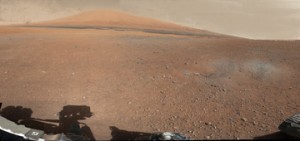
View of Mount Sharp from the Mars Rover "Curiosity" (Credit: NASA/JPL)
Curiosity was launched November 26, 2011, at 10:02 EST and landed on Mars at Gale Crater close to midnight on August 5, 2012. Curiosity used a much more precise landing system than previously attempted. Thanks to the people at NASA and JPF, Curiosity is now going about it’s business assessing the habitability of the Red Planet.
A primary mission objective is to determine whether Mars is or has ever been able to support life. Curiosity can chemically analyze samples by scooping up soil, drilling rocks, and using a laser sensor system.
Other goals of this mission are to collect data for a human mission, study Martian geology and study the climate. The discoveries on Mars may help us address climate change issues on Earth.
The Curiosity rover is about five times larger than the Spirit or Opportuity Mars Exploration Rovers and carries more than ten times the mass of scientific instruments. Curiosity will explore for at least 687 Earth days (1 Martian year) over a range of 5–20 km (3–12 miles).
The Mars Science Laboratory mission is part of NASA’s Mars Exploration Program, a long-term effort of robotic exploration of Mars. The project is managed by the Jet Propulsion Laboratory of the California Institute of Technology for NASA. The total cost of the MSL project is about US $2.5 billion.
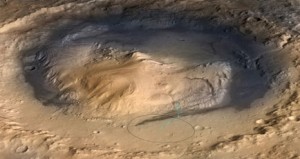
Curiosity was launched November 26, 2011, at 10:02 EST and landed on Mars at Gale Crater, near Mount Sharp on August 6, 2012. Image Credit: NASA/JPL-Cal Tech
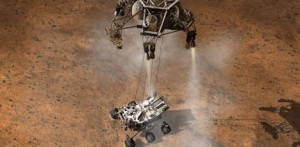
Entry, descent, and landing for the Mars Science Laboratory missionwill use a guided entry and a sky crane touchdown system to land the hyper-capable, massive rover.Image credit: NASA/JPL-Caltech
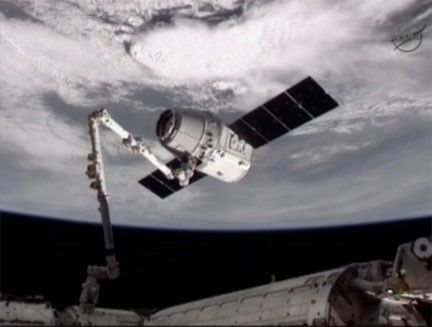
by SpaceJace | May 27, 2012 | News
In a symbolic and historic “handshake”, the astronauts inside the International Space Station reached out with their robotic arm and grabbed the Dragon by the tail. On Friday the first private spacecraft docked with the remote outpost orbiting 200 miles above our heads.
It was more than just supplies the Dragon delivered, but the promise of a carrying crewmembers. Since the retirement of the Space Shuttle, the only other way to orbit is aboard a Russian Soyuz spacecraft
This adventurous and historical feat may create a powerful alliance that re-enables NASA to put more focus on the science of space travel and sending humans to Mars. In addition, the prospects for free enterprise in space are boundless.
Congratulations to Elon Musk and everyone at SpaceX, NASA and the astronauts aboard ISS. This is a great day for people on Earth and another step into a new frontier for all humanity. The civilization we ultimately create in space and the worlds we will visit may well be beyond our wildest imagination.
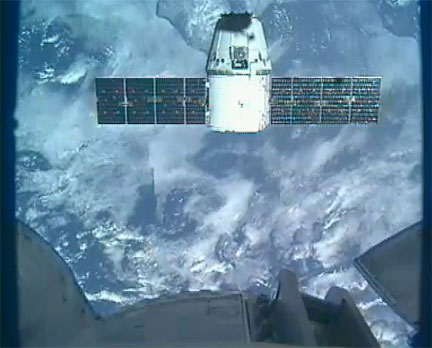
SpaceX's Dragon spacecraft about 30 meters from the station. Photo: NASA

SpaceX Dragon docks with the International Space Station — the first private spacecraft ever to do so. (Credit: NASA)
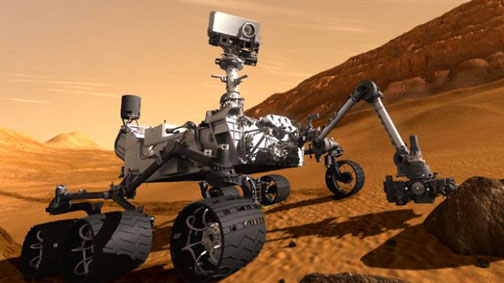
by SpaceJace | Apr 26, 2012 | News
Once again, humans will soon vicariously land on Mars and explore her mysteries through the virtual eyes of Curiosity – NASA’S latest rover on the Red Planet.
Currently in transit to Mars, Curiosity was launched November 26, 2011, at 10:02 EST and is scheduled to land on Mars at Gale Crater, near Mount Sharp on August 6, 2012. Curiosity will try a more precise landing than previously attempted. If the landing is successful, Curiosity will then go about it’s business assessing the habitability of the Red Planet.
A primary mission objective is to determine whether Mars is or has ever been able to support life. Curiosity can chemically analyze samples by scooping up soil, drilling rocks, and using a laser sensor system.
Other goals of this mission are to collect data for a human mission, study Martian geology and study the climate. The discoveries on Mars may help us address climate change issues on Earth.
The Curiosity rover is about five times larger than the Spirit or Opportuity Mars Exploration Rovers and carries more than ten times the mass of scientific instruments. Curiosity will explore for at least 687 Earth days (1 Martian year) over a range of 5–20 km (3–12 miles).
The Mars Science Laboratory mission is part of NASA’s Mars Exploration Program, a long-term effort of robotic exploration of Mars. The project is managed by the Jet Propulsion Laboratory of the California Institute of Technology for NASA. The total cost of the MSL project is about US $2.5 billion.

Currently in transit to Mars, Curiosity was launched November 26, 2011, at 10:02 EST and is scheduled to land on Mars at Gale Crater, near Mount Sharp on August 6, 2012. Image Credit: NASA/JPL-Cal Tech

Entry, descent, and landing for the Mars Science Laboratory missionwill use a guided entry and a sky crane touchdown system to land the hyper-capable, massive rover.Image credit: NASA/JPL-Caltech
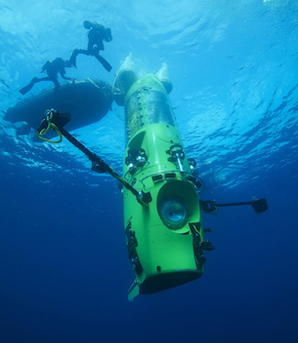
by SpaceJace | Apr 23, 2012 | News
From Oceans to Space
More people have walked on the moon than traveled to the deepest depths of the oceans.
On March 26, 2012 filmmaker James Cameron joined the only other two humans who have traveled to the deepest realms of the Earth’s ocean – plunging nearly 11km (seven miles) down to the deepest place in the ocean, the Marianas Trench in the western Pacific.
Cameron’s trip is the first attempt by humans to reach the Challenger Deep, the deepest point of the Marianas Trench, since two Navy men touched bottom inJanuary 1960. On that trip, Don Walsh and Jacques Piccard spent a mere 20 minutes on the bottom inside the bathyscaphe Trieste, the only two humans before Cameron to travel the deepest point in the ocean abyss, the Marianas Trench, 35,830 feet beneath the surface.
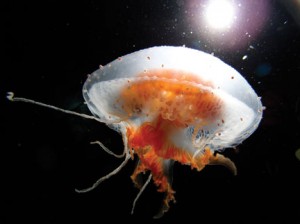
Under the Antarctic ice, a jellyfish species, Diplulmaris antarctica, floats with the current. It's colorless umbrella can be up to 8 inches in diameter. image credit: Steve Clabuesch, National Science Foundation.
“Adventuring under the sea is an unearthly experience,” wrote aquanaut William Beebe in 1960. “And in all except one sense we are actually entering a new world when we put on a diving helmet and float down to the white coral sand. The only other place comparable to these marvelous nether regions must surely be naked space itself, out far beyond atmosphere, between the stars, where sunlight has no grip upon the dust and rubbish of our planetary air, where the blackness of space, the shining planets, comets, suns and stars must really be closely akin to the world of life as it appears to the eyes of an awed human being in the open ocean a half mile down. In my present existence there is only one experience left which can transcend that of living for a time under the sea—and that is a trip to Mars.”

William Bebee peers out from inside one of his inventions - a bathyscaphe called Trieste that carried two men to the deepest place on Earth, the Marianas Trench, 35,830 feet beneath the surface of the Pacific Ocean in 1960. Image Credit: The Wildlife Society
When orbiting in the blackness of space, space travelers relish the deep blue view of the oceans that cover approximately 3/4 of Earth’s surface. Ocean travelers, on the other hand, don’t simply look down at Earth from space. Seafarers are part of the planet and subject to the power of weather and waves. Alone on a vast horizon except for shipmates and the ship, all you have to do is look up into the sky to realize you’re already in space.
As for the undersea world, almost anyone can experience the watery realm without even getting wet, thanks to a variety of submarines.
A weekend sub-sea traveler can explore depths up to 200 feet inside a comfortable tourist submarine. The more adventurous can ride a specialized deep-diving submersible to visit the historic Titanic or giant pink tubeworms living next to undersea volcanoes. For a truly enveloping near-space experience, try snorkeling or scuba diving in the deep blue vastness of the ocean surface.
Everyday Travel Tip
Take a break from cyberspace and immerse yourself in inner space. Learn to scuba dive.
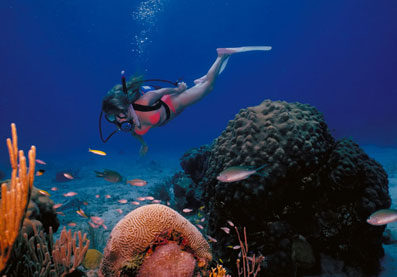
- (c) illstudio / www.fotosearch.com
Here are two leading scuba diving organizations.
National Association of Underwater Instr. (NAUI)
Professional Association of Dive Instructors (PADI)
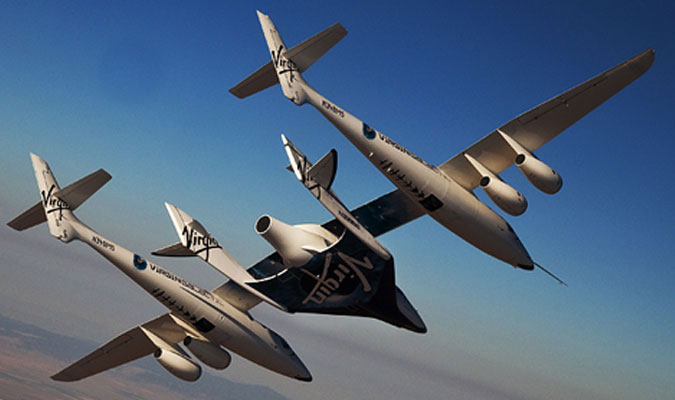
by SpaceJace | Apr 23, 2012 | News
Private Space Travel is Here
If you are alive today, you have a very real opportunity of traveling to space before you die. Whether you personally fly to space or not, private space travel will have a tremendous effect on all our lives.
Advances in private space travel, once the domain of a privileged few, are making it possible for everyday people to have the profound experience of space flight. Armchair astronauts can finally live the dream on board passenger spacecraft built by Virgin Airlines founder Richard Branson and Burt Rutan, the designer of history-making SpaceShipOne. Virgin Galactic’s passenger spacecraft can carry six people to the edge of space where they float weightless and view the awesome Earth below.
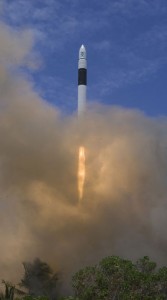
Falcon 9 rocket launch. Space X/Chris Thompson
Other prominent millionaires investing some of their fortunes in private space travel include Jeff Bezos, founder of Amazon.com. This successful book entrepreneur is developing a spacecraft that flies like those envisioned in early science fiction novels. Elon Musk, founder of Paypal, created Space X and the Falcon 9 rocket that soon carry astronauts to the International Space Station. Robert Bigelow, founder of theBudget Suites hotel chain, is test-flying inflatable cabin modules for a future space hotel.
Many of us from all walks of life want to space-travel. We have dreamed of these journeys while enjoying space-themed movies, TV programs and books. Space travel is compelling, whether it’s the desire to have a life-changing view of Earth from orbit or to float weightless in space as in our flying dreams.
Polls show that over half of us would like to travel in space. The list includes celebrities such as actor Tom Hanks, movie director James Cameron and renowned physics professor Stephen Hawking; as well as everyone from high school teachers to starry-eyed children, to me and maybe you too.
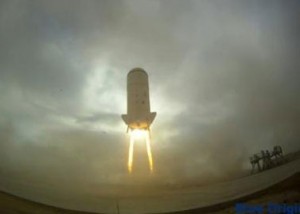
Blue Origin - Test Launch
If someone had told your great-great-grandfather back in 1904—when the Wright Brothers took their short but historic flight—that within a decade a passenger airline service would be operating in America, he probably would have laughed—along with the rest of the world. Today, thanks to the Wright Brothers and others, the everyday person can take an afternoon suborbital flight to the edge of space or go all the way to orbit and circle the entire planet every ninety minutes while floating weightless.
We are entering a new space age – the dawning of a space-traveler society here on Earth.















